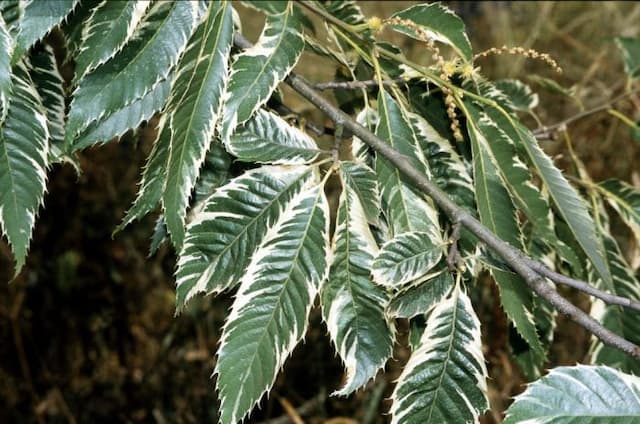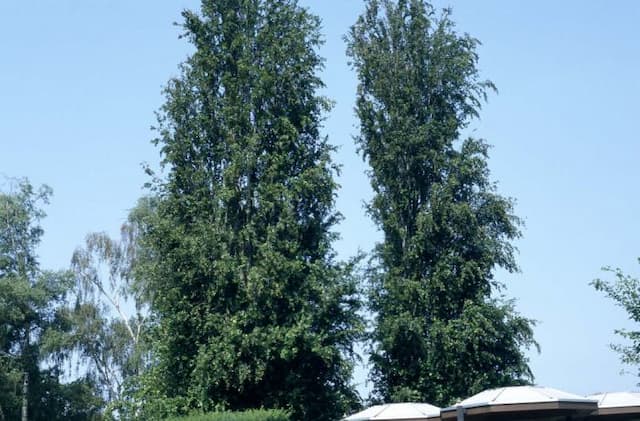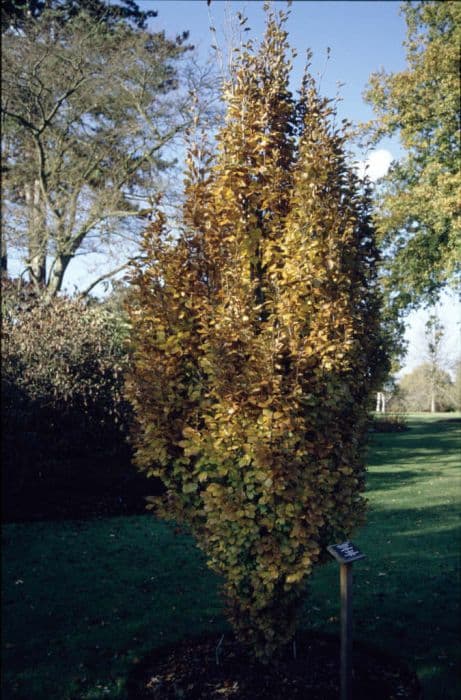Daimyo Oak Quercus dentata 'Carl Ferris Miller'

ABOUT
Known as the Daimyo oak, 'Carl Ferris Miller' is a deciduous tree that is recognized for its stately and picturesque appearance. It boasts a broad, rounded canopy that provides ample shade. During the spring, the tree is adorned with new foliage that emerges in shades of pink and bronze, maturing into a luscious dark green as the season progresses. These leaves are distinctive with their deeply toothed edges, offering a unique texture to the plant's profile. Come autumn, the Daimyo oak transforms yet again, with its leaves assuming striking shades of red, orange, and yellow, offering a warm and vibrant display. In addition to its colorful foliage, the tree produces acorns which are favored by wildlife. These acorns have a classic, rounded shape, enclosed at their base by a scaly cup. The bark of the Daimyo oak 'Carl Ferris Miller' adds to its visual interest, featuring a rough and ridged texture that provides character to the tree throughout the year. Despite the size exclusion from this description, the plant's grandeur is evident in its majestic presence and the substantial spread of its canopy.
About this plant
 Names
NamesFamily
Fagaceae
Synonyms
Japanese Emperor Oak, Daimyo Oak
Common names
Quercus dentata 'Carl Ferris Miller'.
 Toxicity
ToxicityTo humans
The Quercus dentata 'Carl Ferris Miller' is a type of oak tree. Oak trees are generally not considered highly toxic to humans; however, they do contain tannins and can sometimes have other compounds that might be harmful if ingested in large quantities. Eating large amounts of acorns or young oak leaves may cause stomach upset, nausea, vomiting, and diarrhea due to the high tannin content. While not commonly ingested by humans in significant amounts, caution is still advised.
To pets
The Quercus dentata 'Carl Ferris Miller', commonly known as the oak tree, can be toxic to pets, particularly dogs, cats, and horses if they ingest part of the tree. The most problematic components are the acorns and young leaves, which contain tannins and other compounds that can cause gastrointestinal distress. Ingesting acorns or leaves in large amounts can lead to symptoms such as vomiting, diarrhea, abdominal pain, and reduced appetite in pets. In severe cases, especially with animals that consume a large number of acorns, there is a risk of kidney damage or even life-threatening complications. Pet owners should prevent their animals from eating substantial amounts of acorns or oak leaves.
 Characteristics
CharacteristicsLife cycle
Perennials
Foliage type
Deciduous
Color of leaves
Green
Height
15-20 feet (4.5-6 meters)
Spread
15-20 feet (4.5-6 meters)
Plant type
Tree
Hardiness zones
4-7
Native area
East Asia
Benefits
 General Benefits
General Benefits- Attractive Foliage: Quercus dentata, commonly known as the Daimyo oak, has large, distinctive, toothed leaves which provide visual interest throughout the growing season.
- Shade Provider: The Daimyo oak, due to its broad canopy, is an excellent shade tree and can significantly cool down areas during hot summer months.
- Wildlife Habitat: It offers habitat and food for a variety of wildlife, including birds and small mammals, which feed on the acorns and find refuge in the tree's branches.
- Longevity: Oak trees are known for their long lifespan, providing benefits to the landscape and ecosystem for many generations.
- Seasonal Interest: It displays a seasonal change that adds to the aesthetic of the landscape, with vibrant green leaves in spring and summer turning to golden brown in the fall.
- Drought Tolerance: Once established, Daimyo oak trees can be quite drought-tolerant, making them suitable for xeriscaping or low-water landscapes.
- Erosion Control: The extensive root system of the Daimyo oak can help to stabilize soil and prevent erosion, particularly on slopes or areas with loose soil.
- Cultural and Historical Significance: Oaks often hold cultural, historical, and symbolic importance, which can add an intangible value to the landscape where they're planted.
- Carbon Sequestration: Like all trees, the Daimyo oak plays a role in capturing carbon dioxide from the atmosphere, contributing to the fight against climate change.
 Medical Properties
Medical PropertiesThis plant is not used for medical purposes.
 Air-purifying Qualities
Air-purifying QualitiesThis plant is not specifically known for air purifying qualities.
 Other Uses
Other Uses- Quercus dentata, commonly known as the Daimyo oak, can be used in woodworking and carpentry for making furniture due to its sturdy wood.
- The wood of Daimyo oak is sometimes used in the crafting of musical instruments, contributing a rich resonance to the sound produced.
- In landscape design, the acorns of the Daimyo oak may be used as a natural mulch, providing nutrients to other plants as they decompose.
- The bark of the Daimyo oak can be used in tanning leather, offering an organic source of tannins for the process.
- Due to its strong wood, the Daimyo oak may be utilized in the construction of outdoor structures, such as pergolas and arbors.
- The tree's leaves can serve as a natural dye, providing a range of colors from green to brown depending on the mordant used.
- Daimyo oak branches can be utilized in the art of bonsai, allowing gardeners to create miniature landscapes with this culturally significant tree.
- The large, coarse leaves of the Daimyo oak can be used in crafts, such as imprinting patterns on fabric or paper.
- In some cultures, the Daimyo oak acorns are used in traditional games or as counting tools for educational purposes.
- The beautiful autumn foliage of the Daimyo oak is collected and used for decorative arrangements in homes and public spaces.
Interesting Facts
 Feng Shui
Feng ShuiThe Daimyo oak is not used in Feng Shui practice.
 Zodiac Sign Compitability
Zodiac Sign CompitabilityThe Daimyo oak is not used in astrology practice.
 Plant Symbolism
Plant Symbolism- Strength: As a type of oak tree, Quercus dentata 'Carl Ferris Miller', commonly known as the Daimyo oak, symbolizes strength due to the hardiness and robustness of oaks in general.
- Endurance: The oak's ability to live for hundreds of years and withstand harsh weather symbolizes endurance and resilience.
- Wisdom: In various cultures, the oak tree is often associated with wisdom because of its long lifespan and its role in mythologies as a sacred tree of knowledge.
- Nobility: The majestic stature of oak trees, including the Daimyo oak, has led to its symbolism of nobility and dignity.
- Stability: With its deep root system, the oak stands for stability and grounding, which can be related to the Daimyo oak's presence.
 Water
WaterThe Daimyo oak, commonly known as Quercus dentata 'Carl Ferris Miller', should be watered deeply and infrequently to mimic its natural habitat. Young trees benefit from watering once a week with about 15-20 gallons of water, allowing soil to dry between waterings. Mature oaks are drought-tolerant and may only need supplemental watering during prolonged dry spells every 2 to 3 weeks with 20-30 gallons, depending on the weather conditions. It is essential to avoid overwatering as it can lead to root rot. Always check the soil moisture a few inches below the surface to determine if the tree needs watering
 Light
LightThe Daimyo oak prefers full sun to partial shade. It thrives in a spot that receives at least six hours of direct sunlight daily, though it can tolerate some light shade. The ideal location would be one that offers bright, unfiltered sunlight for the majority of the day, as this promotes healthy growth and dense foliage.
 Temperature
TemperatureThe Daimyo oak is hardy and can withstand a broad range of temperatures, surviving minimum temperature dips to around -20°F. It performs best in temperatures that are typically between 60°F and 80°F. Extreme heat above 100°F might stress the tree, so it should be monitored and provided with adequate water during hot spells to help maintain health.
 Pruning
PruningThe Daimyo oak should be pruned to remove dead or broken branches, improve shape, and encourage healthy growth. Pruning should be done in late winter to early spring before new growth starts. Limit the pruning to no more than once a year, focusing on removing only the necessary branches and keeping cuts clean to avoid disease.
 Cleaning
CleaningAs needed
 Soil
SoilThe Japanese Emperor Oak prefers a well-draining, loamy soil with a pH of 5.5 to 7.5. The best soil mix might include garden soil, compost, and coarse sand to improve drainage. It's important to ensure that the soil remains moist but not waterlogged to avoid root rot.
 Repotting
RepottingThe Japanese Emperor Oak, being a large tree, is not commonly repotted. When young, it may be repotted every 2-3 years. However, as it matures and is planted outdoors, repotting is replaced by transplanting, if necessary, which is seldom done due to its size.
 Humidity & Misting
Humidity & MistingThe Japanese Emperor Oak can tolerate a wide range of humidity levels but thrives in moderate to high humidity. It does well outdoors where natural humidity provides the necessary conditions, without needing special attention to humidity levels indoors.
 Suitable locations
Suitable locationsIndoor
Not suitable for indoor growth due to size.
Outdoor
Plant in sun, well-draining soil, space to grow.
Hardiness zone
4-8 USDA
 Life cycle
Life cycleThe life cycle of Quercus dentata 'Carl Ferris Miller', commonly known as the Daimyo Oak, starts with acorn germination when the seed establishes itself in suitably moist and well-draining soil. Seedling growth follows, characterized by the development of a taproot and initial leaves which will photosynthesize to fuel growth. As the sapling stage commences, the oak grows in height and breadth, slowly developing its distinctive large, coarsely toothed leaves. In maturity, the tree continues to expand, producing a broad canopy and beginning to reproduce by generating acorns that attract wildlife, which in turn helps in their dispersal. The mature stage can last for many decades, with the tree continuing to grow and produce acorns annually. Eventually, the Daimyo Oak enters a phase of senescence where growth slows, and the tree may become susceptible to disease or environmental stress, leading to its decline and death.
 Propogation
PropogationPropogation time
Spring to Summer
The Quercus dentata 'Carl Ferris Miller', commonly known as the Daimyo oak, is typically propagated using acorns (seeds). The most popular method of propagation for this oak is seed sowing. To propagate the Daimyo oak from acorns, the best time to start is in the fall, shortly after the acorns have fallen from the tree. You should first select healthy, undamaged acorns and then plant them in a well-draining soil mix. Providing a cold stratification period, which mimics the natural winter conditions, may enhance germination rates. This can be done by keeping the acorns in a refrigerated environment for approximately 60 to 90 days. After the stratification period, plant the acorns in the soil about 1 to 2 inches deep, and with time, given the right moisture and temperature conditions, they will germinate and grow into new Daimyo oak trees.









